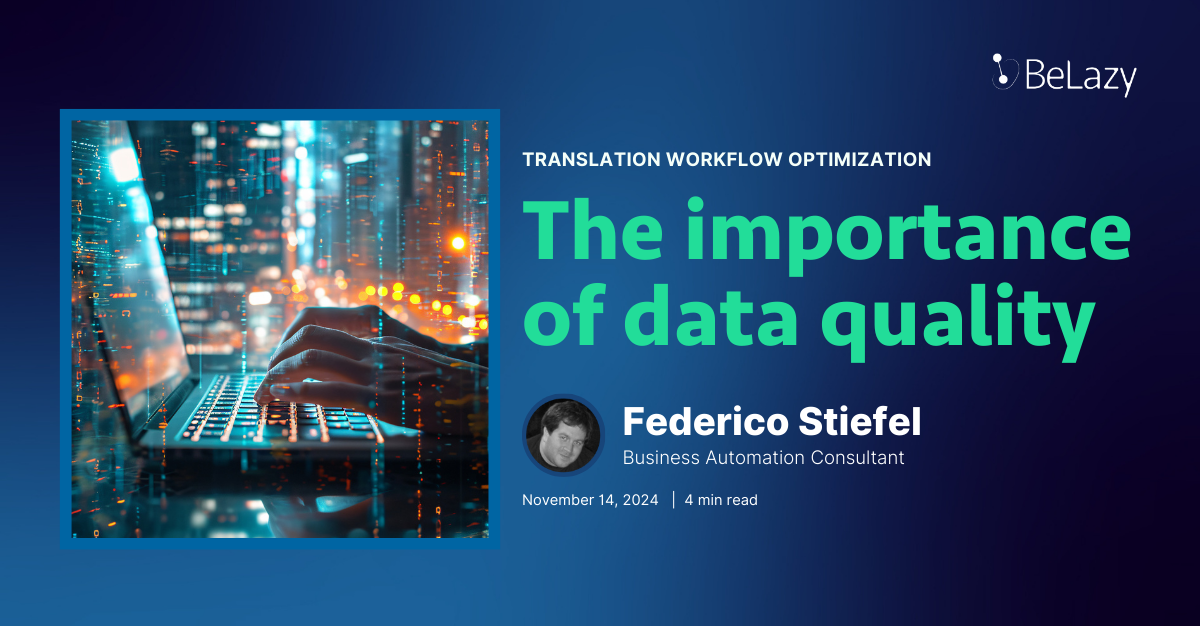When we started BeLazy more than 2 years ago, we assumed that it was enough if our offering were a relatively simple tool that copy-pastes the incoming project information from vendor portals into business management systems. More than anything, we wanted to develop a productivity tool for project managers.
Quickly, we realized that only copy-pasting information was not sufficient for our potential customers. That’s why we then introduced end-to-end automation (fully automated workflows), but after feedback from real project managers, the concept evolved once again, and that’s how we came up with the idea of the virtual project manager.
A virtual project manager does the automation work but is also flexible enough to help with the supervision work of human project managers by creating and managing those projects according to their habits.
Today, subscribing to BeLazy equals adding a virtual project manager to your company. You need to train him like other team members, but just like a virtual assistant, it is available 24/7, never leaves the office, and doesn’t complain about monotonous work. Not surprisingly, we have seen that our clients treat BeLazy as a person. First, there is little trust in its capabilities, but soon it becomes a fundamental member of the team.
BeLazy doesn’t compete or replace your existing team. Think of it as an entry-level project manager that helps your other PMs do more value-added jobs. In most translation companies, BeLazy’s tasks are traditionally done by other humans — as a matter of fact, when we started, most people didn’t believe that a virtual project manager with this degree of sophistication was even possible. Therefore, the cost of BeLazy is best compared to hiring and training an entry-level PM.
However, quantifying how much a translation project costs is never easy, and most business owners consider project management as a fixed cost, even though they also know that’s not true. It took us a while to think about a simple and understandable model of the associated project management cost in a translation job that also favors small, repeating microtransactions.
In previous blog posts, we analyzed the hourly total cost of human project managers and how much time it takes to manage a project. Now we came up with an online tool that helps you understand whether using BeLazy is convenient in your organization set up, or if you are better off hiring a new colleague.

THE BELAZY ROI CALCULATOR
This tool takes into account a few variables:
- How many minutes it takes to manage a project in one target language. Usually, the first language takes the longest. Depending on the complexity of the project and the systems you use, this can be anywhere between 8 and 30 minutes, or even longer.
- How many minutes extra of project management does each additional language imply. You have to prepare the jobs, instructions, find the right translators, etc. – this is also not insignificant, though automation in business management systems can significantly decrease this time.
- The total hourly cost of a project manager.
See the blog entry for some examples of the real cost per country.
Take this with a pinch of salt, maybe on one customer’s project you spend 10 minutes for the first language and 2 minutes for every additional language, whereas for another’s it takes 20 minutes and 5 minutes each.
Consider that the ROI calculator takes into account only the best-case scenario, where the entire project workflow can be automated. There may be situations when the bulk of the work is done automatically, but there is residual work for the PMs. To calculate the current ROI, just enter the total time spent on a project that relates to the automatable work only. And don’t forget, we want to know how to improve BeLazy’s offering to sort out work that can be automated but isn’t yet.
The ROI calculator gives you an idea of how much money you will save on a project within a few months of deploying the system.
The ROI calculator gives you an idea of how much money you will save on a project within a few months of deploying the system. On the left side of the calculator, you see the variables that determine the time and cost of human project management. On the right side, you can see how much a project performed by BeLazy costs.
To calculate the BeLazy cost, we take into consideration factors such as the number of languages in your project and the project value per language. The first variable is a given and also influences the human cost. The second variable is equally important because it is small recurring projects — continuous localization — the ones that benefit the most from automation.
At the end of the calculator page, you can see the difference between human and automated project management, and your estimated savings in euros but also as a relative percentage between both methods.
Why did BeLazy move away from percentage-based pricing?
Previously, BeLazy’s business model was a percentage-based charge on the cost of a project. This kind of model was not the right fit for projects with many target languages, which means BeLazy was not always convenient for multi-language vendors (MLVs). Instead, the new pricing model offers multiple benefits for MLVs that want to integrate with customers’ translation management systems.
We are still honoring the percentage-based fees for existing customers and have introduced several other pricing plans, including a Free package. We recommend the BeLean package for translation companies that work mostly in vendor portals of other LSPs. Just like with every subscription-based service, the more you use it, the cheaper it gets.
The biggest difference with our previous pricing model is today we require monthly minimum spending, which we regard as a fair arrangement, given the amount of support that we provide to our customers.
Want to share your feedback?
We want to hear what you think about the benefits and the ROI for virtual translation project managers. Companies like RWS or Transperfect have millions of dollars worth of translation projects processed with no human intervention. BeLazy is now democratizing this technology, allowing smaller and mid-sized LSPs to enjoy the same benefits that are key for scalability and growth, at fair pricing







